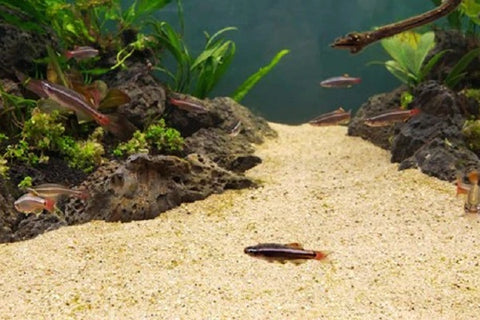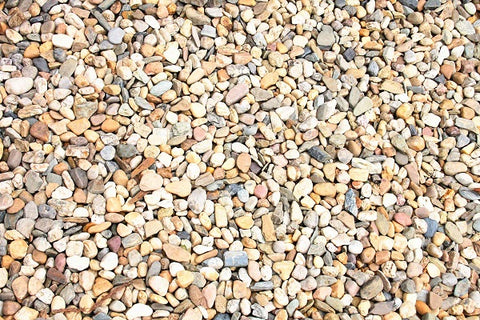Aquarists nowadays use various substrates at the bottom of aquariums. Depending on the fish, you can make choices on which one to use. Among different substrates, sand and gravel might be a common choice. Each of them has its pros and cons.
In this article, we will provide you with a detailed overview of sand versus gravel. So, you can decide which one is better for your aquarium.
Aquarium sand
Aquarium sand is the most important material for creating an artificial underwater landscape for your fish. It provides a substrate for your fish and other aquatic creatures to swim around and explore.
These sands are typically 1 to 2 mm (1/16 to 1/8 inch) in diameter and 3 to 6 mm (1/8 to 1/4 inch) in length. With this grade of sand for aquariums, you will have a very smooth finish and a very good flow of water. It is ideal for many aquariums.

Components of aquarium sand
The aquarium sand is composed of two different types of products, which are natural sand and black diamond. Compared to natural sand, the black diamond is better since it can help keep the aquarium clean, healthy and safe for fish and other aquatic life.
The aquarium sand should be stirred regularly to make it clean and healthy. The beneficial bacteria present on the black diamond help to eliminate harmful chemicals from the water, which can be a threat to the life of fish if allowed to remain in a large amount.
On the other hand, the black diamond sand is much better than the natural sand because it holds algae and bacteria which are very helpful for the fish to survive in the water tank. The bacteria are helpful to control the water nitrate and ammonia level, thereby eliminating any harmful effect on fish.
Advantages
Aquarium sand is highly appreciated as a decorative material and is usually used to cover the bottom part of the aquariums.
- Add more beauty and style to your aquariums.
- Hygienic and durable.
- Wide application, suitable for most aquariums.
- Leave no trace in the aquarium water.
- Have smaller gaps, and the food material cannot sink since it will stay on the top of the substrate.
- Natural materials like SeaChem and ReefSand offer more benefits than traditional gravels, including greater buffering capacity and higher pH stability.
- Help keep more oxygen in the water tank.
Disadvantages
People who own fish tanks will buy this sand, but there are a few disadvantages to using this type of sand.
- The biggest disadvantage is that this sand can be quite pricey and it's not recommended that you used it for smaller fish tanks and aquariums.
- If you use aquarium sand, you'll want to wipe down your aquarium glass every few days so that you don't get slimy algae growing on your glass, making it harder for you to see your fish.
- If fish accidentally eats sand particles, it will cause intestinal blockage.
Aquarium gravel
Aquarium gravel, sometimes called aquarium sand or just sand, is a fine mix of small rocks and minerals that are used in the home aquarium to provide a substrate for plants and a substrate for fish that do not require a very fine substrate of an aquatic plant tank.
Aquarium gravel is mostly used in aquariums and fish tanks to create an environment that is ideal for fish, plants, and other aquatic life. Aquarium gravel is the most important thing in your aquarium if you are planning to build one at home or office. The aquarium gravels will be present in any type of aquarium, whether it is salt water or fresh water.

Advantages
- The gravel acts as a more natural environment for the fish to live in than a bare tank.
- It is designed to replicate the bottom of a river, stream, or lake in an aquarium, which has larger stones on the bottom and gradually smaller rocks as you go deeper into the water.
- It is known that good gravel will help maintain the stability of your tank and it will keep a good habitat for the plants and animals.
- It plays an important part in the health and longevity of your fish.
- It maintains the flow rate of water, thus allowing to avoid any algae, amoeba, and bacteria buildup.
Disadvantages
- When you replace your aquarium water you will also be replacing all the beneficial bacteria along with it. This can shock your fish and cause them to die if they do not have a haven to hide in during this time.
- The major disadvantage is the more time to clean the tank. Gravel has cracks, so all the food and other waste trap inside the cracks. Thus, creating difficulty in cleaning.
- Gravel residue and dust associated with it can kill the fish. So, it is necessary to clean the new gravel appropriately to maintain the water quality.
Why there is a layer of sand rather than gravel at the aquarium bottom?
This is because soft water fish need a calmer environment with low water flow, while saltwater fish can be accommodated in high water flow tanks with gravel.
Using high-quality gravel or even regular river rock will be cheap, and cheaper than aquarium sand, and it will be much more beneficial for your fish.
Conclusion
In the above article, we have provided both experience and beginner aquarists with the necessary information about Sand vs Gravel. So, they have a better idea of which one to be used according to the requirements.
We have listed both pros and cons of the sand and gravel to take better care of them when you are using them in your tank. We hope that you have liked our article and don’t forget to share it with the aquarium community.


Comments (0)
Back to Beginner Guide & Advice